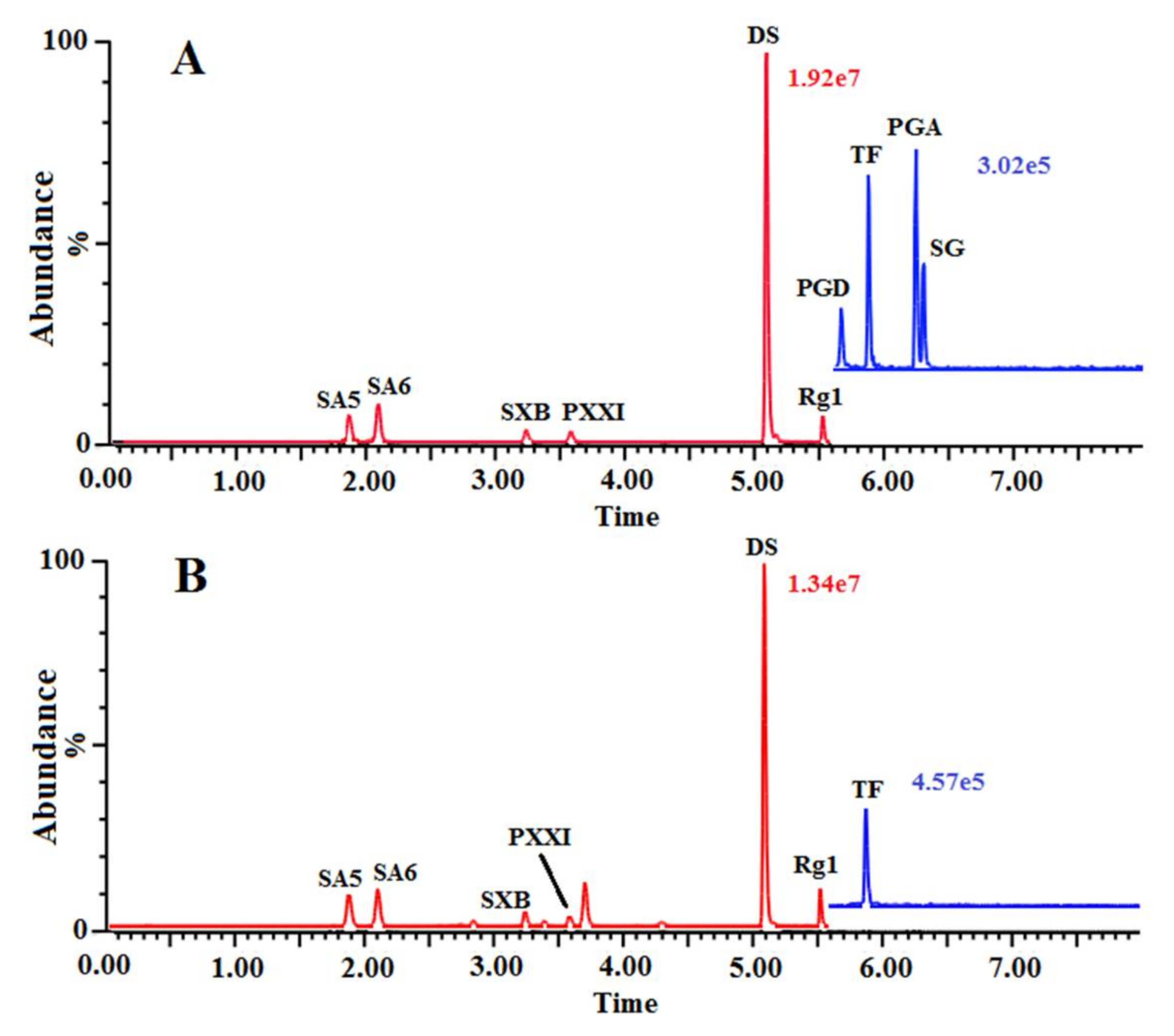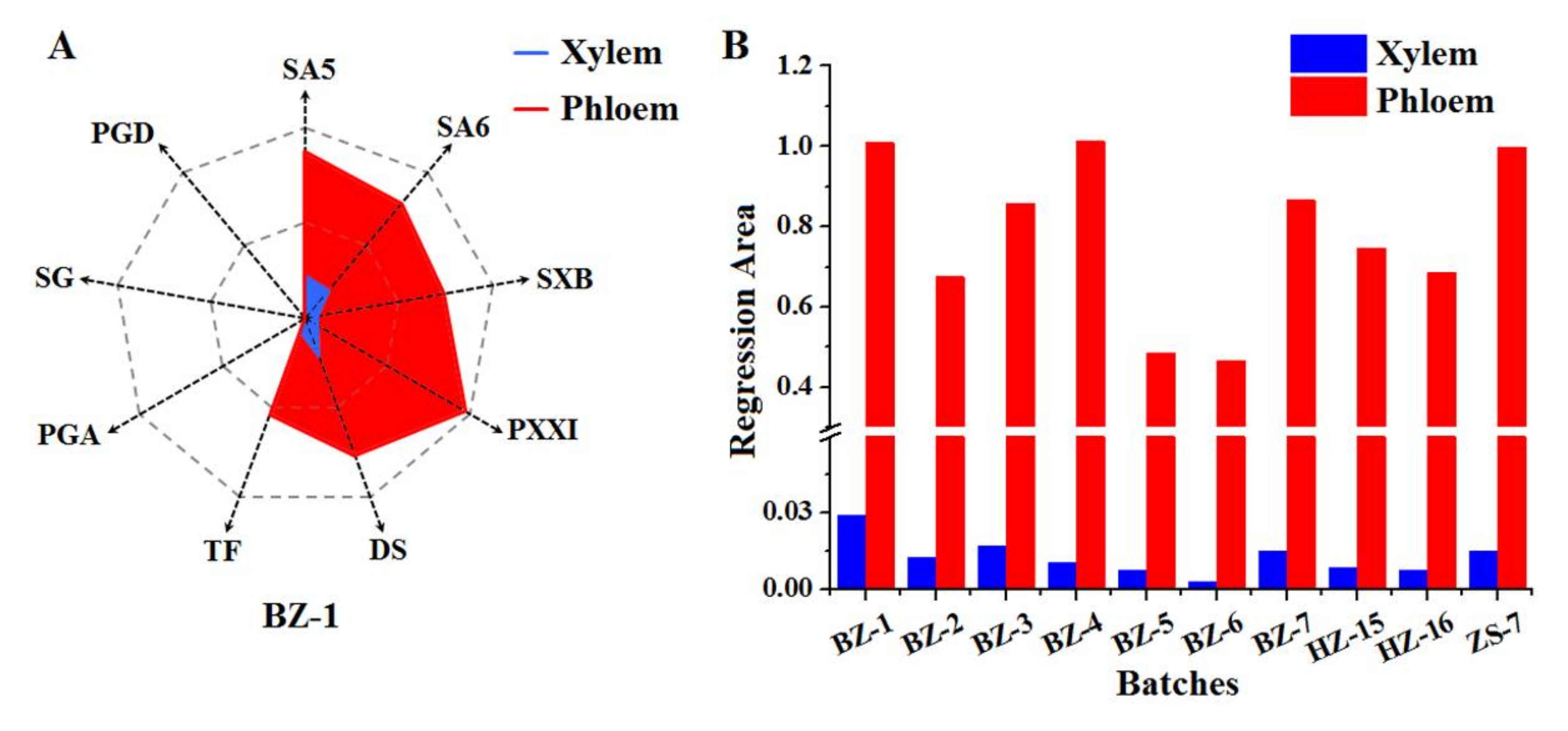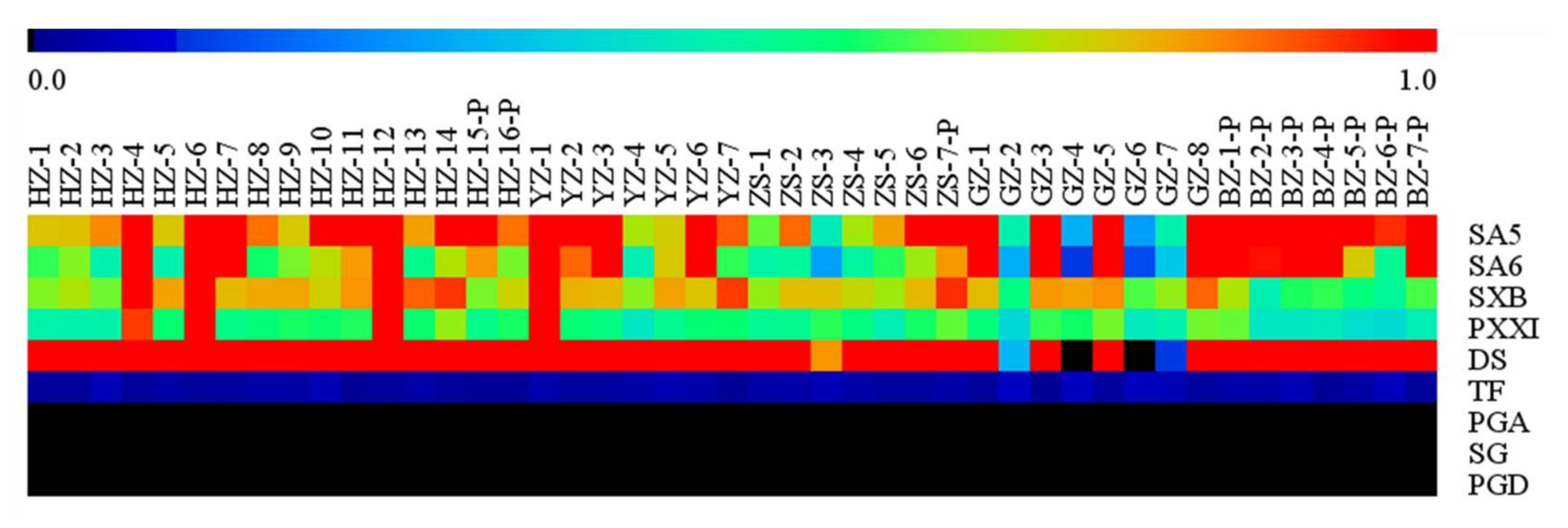Illumination on “Reserving Phloem and Discarding Xylem” and Quality Evaluation of Radix polygalae by Determining Oligosaccharide Esters, Saponins, and Xanthones
Abstract
:1. Introduction
2. Results and Discussion
2.1. Optimization of UPLC-ESI-MS/MS Conditions and Sample Preparation
2.2. Methodological Validation of the Quantitative Analysis
2.3. Distribution Analysis of Interesting Compounds in RP’s Xylem and Phloem
2.4. The Heat Map Analysis of Interesting Compounds in the Samples from Different Origins
2.5. The Correlation between the Bioactive Compounds’ Content and RP’s Diameter
3. Materials and Methods
3.1. Reagents and Materials
3.2. Standard Solution Preparation
3.3. Sample Preparation
3.4. UPLC-MS/MS Conditions
3.5. Method Validation
3.6. Data Analysis
4. Conclusions
Supplementary Materials
Acknowledgments
Author Contributions
Conflicts of Interest
References
- National Commission of Chinese Pharmacopoeia. Pharmacopoeia of the People’s Republic of China; Chinese Medical Science and Technology Press: Beijing, China, 2015; Volume 1, p. 156. ISBN 978-7-5067-7337-9. [Google Scholar]
- Ren, M.X.; Guo, J.M. Handbook of Modern Chinese Medicine Processing; China Press of Traditional Chinese Medicine: Beijing, China, 2002; pp. 350–351. ISBN 9787801562968. [Google Scholar]
- Naito, R.; Tohda, C. Characterization of anti-neurodegenerative effects of Polygala tenuifoliain A β (25–35)-treated cortical neurons. Biol. Pharm. Bull. 2006, 29, 1892–1896. [Google Scholar] [CrossRef] [PubMed]
- Ikeya, Y.; Takeda, S.; Tunakawa, M.; Karakida, H.; Toda, K.; Yamaguchi, T.; Aburada, M. Cognitive improving and cerebral protective effects of acylated oligosaccharides in polygala tenuifolia. Biol. Pharm. Bull. 2004, 27, 1081–1085. [Google Scholar] [CrossRef] [PubMed]
- Liu, P.; Hu, Y.; Guo, D.H.; Wang, D.X.; Tu, H.H.; Ma, L.; Xie, T.T.; Kong, L.Y. Potential antidepressant properties of radix polygalae (Yuan Zhi). Phytomedicine 2010, 17, 794–799. [Google Scholar] [CrossRef] [PubMed]
- Hu, Y.; Liao, H.B.; Dai-Hong, G.; Liu, P.; Wang, Y.Y.; Rahman, K. Antidepressant-like effects of 3,6′-disinapoyl sucrose on hippocampal neuronal plasticity and neurotrophic signal pathway in chronically mild stressed rats. Neurochem. Int. 2010, 56, 461–465. [Google Scholar] [CrossRef] [PubMed]
- Cao, Q.; Jiang, Y.; Cui, S.Y.; Tu, P.F.; Chen, Y.M.; Ma, X.L.; Cui, X.Y.; Huang, Y.L.; Ding, H.; Song, J.Z.; et al. Tenuifolin, a saponin derived from Radix Polygalae, exhibits sleep-enhancing effects in mice. Phytomedicine 2016, 23, 1797–1805. [Google Scholar] [CrossRef] [PubMed]
- Kim, K.S.; Lee, D.S.; Bae, G.S.; Park, S.J.; Kang, D.G.; Lee, H.S.; Oh, H.; Kim, Y.C. The inhibition of JNK MAPK and NF-κB signaling by tenuifoliside A isolated from Polygala tenuifolia in lipopolysaccharide-induced macrophages is associated with its anti-inflammatory effect. Eur. J. Pharmacol. 2013, 721, 267–276. [Google Scholar] [CrossRef] [PubMed]
- Chung, I.W.; Moore, N.A.; Oh, W.K.; O’Neill, M.F.; Ahn, J.S.; Park, J.B.; Kang, U.G.; Kim, Y.S. Behavioural pharmacology of polygalasaponins indicates potential antipsychotic efficacy. Pharmacol. Biochem. Behav. 2002, 71, 191–195. [Google Scholar] [CrossRef]
- Peng, W.D.; Xu, S.P. Antitussive and expectorant effects of four saponins isolated from Polygala tenuifolia Willd. Chin. Pharm. J. 1998, 33, 491. [Google Scholar]
- De Campos, R.O.; Santos, A.R.; Vaz, Z.R.; Pinheiro, T.R.; Pizzolatti, M.G.; Cechinel Filho, V.; Delle Monache, F.; Yunes, R.A.; Calixto, J.B. Antinociceptive properties of the hydroalcoholic extract and preliminary study of a xanthone isolated from Polygala cyparissias (Polygalaceae). Life Sci. 1997, 61, 1619–1630. [Google Scholar] [CrossRef]
- Marston, A.; Hamburger, M.; Sordat-Diserens, I.; Msonthi, J.D.; Hostettmann, K. Xanthones from Polygalae nyikensis. Phytochemistry 1993, 33, 809–812. [Google Scholar] [CrossRef]
- Zhang, M.; Wen, J.M.; Li, W.K.; Mai, N.Q. Study on telomerase activity during induction of axon-like and dendrite-like processes in neuroblastoma cells. Chin. J. Nerv. Ment. Dis. 2001, 27, 279–282. [Google Scholar]
- Li, S.Z. Compendium of Materia Medica; People’s Medical Publishing House: Beijing, China, 1982; ISBN 9787117061179. [Google Scholar]
- Lei, X. Lei’s Treatise on Preparing Drugs; Jiangsu Science and Technology Press: Nanjing, China, 1985. [Google Scholar]
- Li, J.; Dong, X.B.; Jiang, Y.; Gao, Q.T.; Jiang, Z.Y.; Cheung, A.W.; Duan, R.; Dong, T.T.; Tu, P.F.; Tsim, K.W. Simultaneous determination of phenols in Radix Polygalae by high performance liquid chromatography: Quality assurance of herbs from different regions and seasons. J. Sep. Sci. 2007, 30, 2583–2589. [Google Scholar] [CrossRef] [PubMed]
- Li, J.; Dong, X.B.; Jiang, Y.; Dong, T.X.; Tu, P.F.; Zhan, H.Q. HPLC determination of total saponins in Radix Polygalae. Chin. J. Pharm. Anal. 2007, 27, 1329–1332. [Google Scholar]
- Chen, S.L.; Lin, L.L.; Chen, S.B.; Yang, D.J.; Yang, J.S.; Xiao, P.G. Quantitative determination of nine xanthones in Polygala caudata and fingerprinting of Polygala L. by HPLC. J. Liq. Chromatogr. Relat. Technol. 2005, 28, 2953–2963. [Google Scholar] [CrossRef]
- Ling, Y.; Li, Z.X.; Chen, M.C.; Sun, Z.L.; Fan, M.S.; Huang, C.G. Analysis and detection of the chemical constituents of Radix Polygalae and their metabolites in rats after oral administration by ultra-high-performance liquid chromatography coupled with electrospray ionization quadrupole time-of-flight tandem mass spectrometry. J. Pharm. Biomed. Anal. 2013, 85, 1–13. [Google Scholar] [CrossRef] [PubMed]
- Yang, G.H.; Cheng, H.; Huang, Q.; Yan, Z.H.; Yang, W.L.; Chen, H.F.; Yuan, J.B. Determination of Polygalaxanthone Ⅲ and 3,6′-disinapoyl sucrose in Polygala tenuifolia by HPLC-MS/MS. Chin. J. Exp. Tradit. Med. Formulae 2014, 20, 39–42. [Google Scholar]
- Lin, L.F.; Yan, L.; Zhang, H.; Li, X.C.; Zhang, J.; Dou, H.R.; Shen, M.R.; Yin, X.B.; Qu, C.H.; Ni, J. Simultaneous analysis of polygala acid, senegenin and 3,6′-disinapoyl sucrose in rat plasma by liquid chromatography-tandem mass spectrometry: application to a pharmacokinetic study after oral administration. Biomed. Chromatogr. 2014, 28, 594–600. [Google Scholar] [CrossRef] [PubMed]
- Dan, W.; He, J.R.; Jiang, Y.M.; Yang, B. Quality analysis of Polygala tenuifolia root by ultrahigh performance liquid chromatography-tandem mass spectrometry and gas chromatography-mass spectrometry. J. Food Drug Anal. 2015, 23, 144–151. [Google Scholar] [CrossRef]
- Liu, Y.F.; Peng, D.Y.; Yang, X.J.; Shi, T.X.; Jing, Y.; Tu, P.F. Comparison of the chemical constituents and pharmacological activities between the cortexes and the roots of Polygala tenuifolia. Chin Pharm. J. 2012, 47, 1975–1979. [Google Scholar]
- Yang, J.; Jiang, Z.Z.; Chai, X.; Zhao, B.C.; Zhao, X.P.; Wang, Y.F. Discriminant analysis of “Q-Markers” of traditional Chinese medical injections—Taking Dan Hong injection as a model. Mod. Tradit. Chin. Med. Mater. Medica-World Sci. Technol. 2016, 18, 2056–2061. [Google Scholar]
- Jiang, Z.Z.; Wang, Y.F. A pattern of hierarchical progression for quality standard of Chinese materia medica based on “herbal origin-material basis-quality markers-quality control method”. Chin. Tradit. Herb. Drugs 2016, 47, 4127–4133. [Google Scholar]
- Hu, Y.; Li, J.; Liu, P.; Chen, X.; Guo, D.H.; Li, Q.S.; Rahman, K. Protection of SH-SY5Y neuronal cells from glutamate-induced apoptosis by 3,6′-disinapoyl sucrose, a Bioactive Compound Isolated from Radix Polygala. J. Biomed. Biotechnol. 2012, 2012, 1–5. [Google Scholar] [CrossRef] [PubMed]
Sample Availability: Samples of the compounds (sibiricose A5, sibiricose A6, sibiricaxanthone B, polygalaxanthone XI, 3,6′-disinapoyl sucrose, polygalacin D, tenuifolin, polygalic acid, and senegenin) are available from the authors. |




| Compound | Formula | tR (min) | MRM Transitions | Cone Voltage (V) | Collision Energy (eV) |
|---|---|---|---|---|---|
| SA5 | C22H30O14 | 1.87 | 517.00→174.92 | 68 | 20 |
| SA6 | C23H32O15 | 2.09 | 547.02→204.96 | 66 | 24 |
| SXB | C24H26O14 | 3.23 | 536.97→314.89 | 82 | 32 |
| PXXI | C25H28O15 | 3.57 | 567.05→271.77 | 88 | 48 |
| DS | C34H42O19 | 5.08 | 753.07→204.96 | 90 | 36 |
| PGD | C57H92O27 | 5.67 | 1207.36→469.04 | 90 | 52 |
| TF | C36H56O12 | 5.86 | 679.15→455.12 | 78 | 24 |
| PGA | C29H44O6 | 6.20 | 487.16→469.13 | 76 | 30 |
| SG | C30H45ClO6 | 6.24 | 535.20→481.09 | 56 | 32 |
| Rg1 (IS) | C42H72O14 | 5.52 | 845.33→799.20 | 70 | 22 |
| Compound | Regression Equations (n = 3) | r | Linear Range (ng/mL) | LOD (ng/mL) | LOQ (ng/mL) | Intra-Day (RSD, %; n = 6) | Inter-Day (RSD, %; n = 3) | Repeatability (n = 6) | Stability | Recovery (n = 6) | ||
|---|---|---|---|---|---|---|---|---|---|---|---|---|
| Mean (µg/g) | RSD (%) | RSD (%) | Recovery (%) | RSD (%) | ||||||||
| SA5 | y = 15.018x − 0.035 | 0.9999 | 8.14–1042 | 0.26 | 0.65 | 2.08 | 5.80 | 1536.17 | 2.44 | 2.00 | 103.3 | 5.35 |
| SA6 | y = 20.351x + 0.0977 | 0.9998 | 8.13–1040 | 0.26 | 0.65 | 1.54 | 3.42 | 1112.03 | 1.74 | 1.59 | 96.92 | 3.46 |
| SXB | y = 10.741x + 0.0485 | 0.9995 | 4.04–517.5 | 0.32 | 0.81 | 2.19 | 8.02 | 661.48 | 2.26 | 1.15 | 97.73 | 5.40 |
| PXXI | y = 9.5114x + 0.0385 | 0.9996 | 4.05–518 | 0.32 | 0.81 | 2.89 | 7.20 | 499.65 | 2.23 | 2.52 | 99.46 | 3.18 |
| DS | y = 22.095x + 2.4691 | 0.9959 | 41.17–5270 | 0.13 | 0.33 | 2.26 | 3.26 | 5394.47 | 2.56 | 2.56 | 97.18 | 2.17 |
| TF | y = 26.907x + 0.0071 | 0.9998 | 0.20–26.05 | 0.10 | 0.41 | 2.37 | 4.62 | 30.92 | 3.97 | 5.01 | 106.2 | 6.12 |
| PGA | y = 33.341x + 0.0057 | 0.9999 | 0.21–26.35 | 0.10 | 0.41 | – | – | – | – | – | 104.2 | 2.81 |
| SG | y = 18.072x + 0.003 | 0.9996 | 0.20–25.75 | 0.20 | 0.80 | – | – | – | – | – | 104.7 | 6.73 |
| PGD | y = 9.7145x + 0.0009 | 0.9996 | 0.20–25.63 | 0.40 | 1.60 | – | – | – | – | – | 97.59 | 3.28 |
© 2018 by the authors. Licensee MDPI, Basel, Switzerland. This article is an open access article distributed under the terms and conditions of the Creative Commons Attribution (CC BY) license (http://creativecommons.org/licenses/by/4.0/).
Share and Cite
Yang, F.; Yu, H.; Chai, X.; Peng, S.; Yang, J.; Wu, D.; Du, J.; Wang, Y. Illumination on “Reserving Phloem and Discarding Xylem” and Quality Evaluation of Radix polygalae by Determining Oligosaccharide Esters, Saponins, and Xanthones. Molecules 2018, 23, 836. https://doi.org/10.3390/molecules23040836
Yang F, Yu H, Chai X, Peng S, Yang J, Wu D, Du J, Wang Y. Illumination on “Reserving Phloem and Discarding Xylem” and Quality Evaluation of Radix polygalae by Determining Oligosaccharide Esters, Saponins, and Xanthones. Molecules. 2018; 23(4):836. https://doi.org/10.3390/molecules23040836
Chicago/Turabian StyleYang, Fan, Huijuan Yu, Xin Chai, Siwei Peng, Junjun Yang, Dan Wu, Jie Du, and Yuefei Wang. 2018. "Illumination on “Reserving Phloem and Discarding Xylem” and Quality Evaluation of Radix polygalae by Determining Oligosaccharide Esters, Saponins, and Xanthones" Molecules 23, no. 4: 836. https://doi.org/10.3390/molecules23040836





